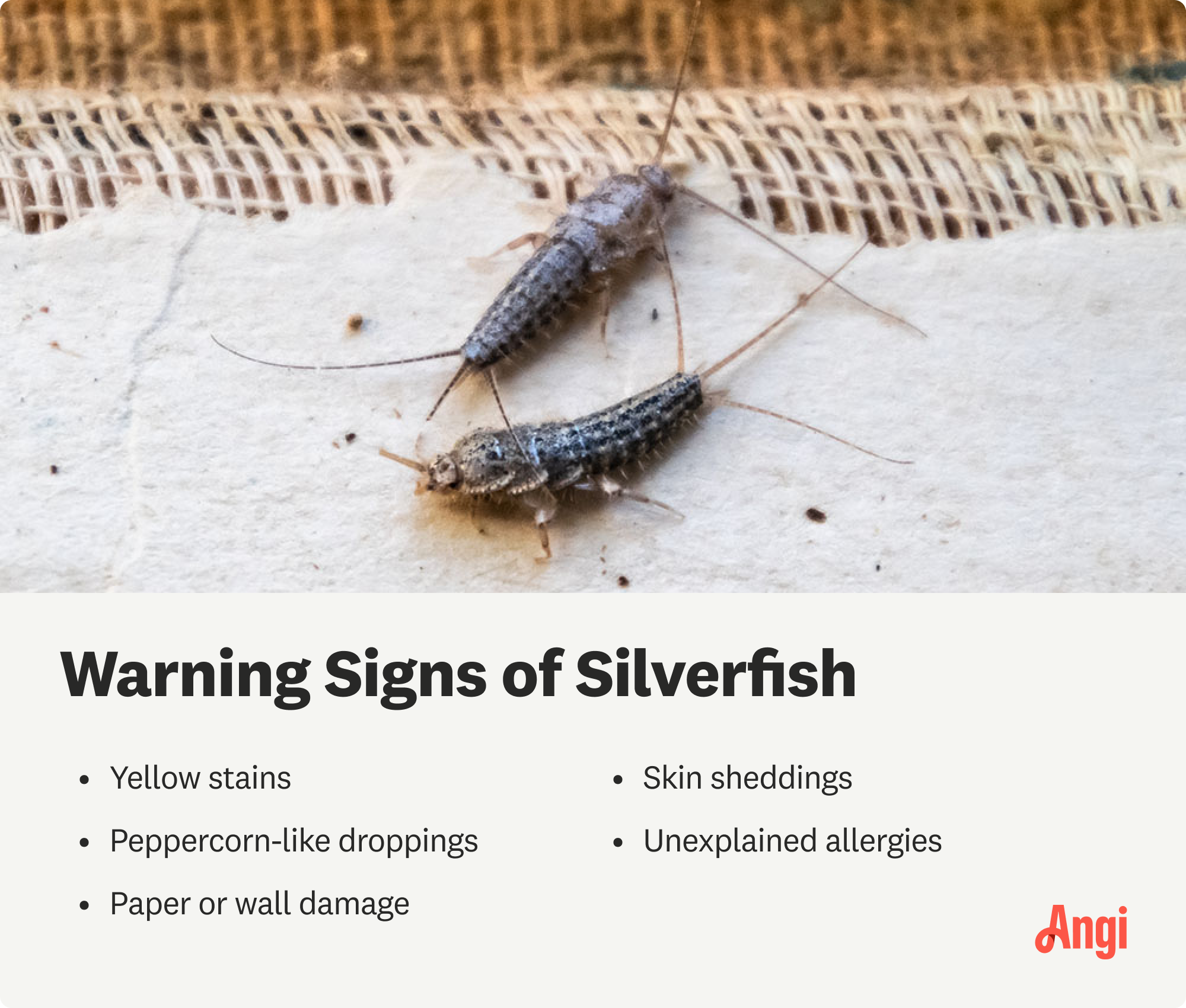What Causes Silverfish? A Complete Guide
Learn the tricks behind these tiny troublemakers


Silverfish are tiny, minnow-like insects that cannot fly but crawl through cracks to find their way into homes.
Silverfish are attracted to dark, damp places and often enter homes looking for food, similar to cockroaches.
While silverfish don’t spread disease or eat wood, they can infest pantries and eat a wide number of materials, including paper, books, photos, cotton, silk, linen, and more.
Insulation, sealing, and moisture control are usually enough to prevent silverfish from becoming a problem.
Silverfish, the aptly named ½-inch, scaly-looking insects with long antenna, are found across the world, often darting away from light or attention. But what causes silverfish to infest a home?
Silverfish have an appetite for everything from precious photographs to hanging curtains, and enter homes in search of food scraps. They’re drawn to dark places and especially love damp spaces, so homes with moisture or humidity problems are common targets. Let’s review the top causes of silverfish and what you can do about it.

Common Causes of Silverfish

Silverfish can be found nearly anywhere in the world and lurk in all types of dark places. Seeing a silverfish now and then, especially in a dark shed or garage, isn’t surprising. But if you spot many of them indoors or notice silverfish-related damage, you likely have one of the following problems.
Damp Homes
Silverfish love two things: Dampness and dark places. In today’s homes, it’s the damp and moisture problems that are the biggest draws for silverfish. Moisture issues in attics, basements, crawlspaces, ductwork, and garages can act like a beacon for silverfish, encouraging them to stick around and breed.
High humidity—the kind that can make magazines sticky—can also bring in the silverfish, so they may be a problem in tropical climates. On the other extreme, silverfish problems appear in very cold areas where snow and ice make puddles indoors or around foundations that silverfish seek out for warmth.
Drafty Older Houses
Silverfish need a way in, so they tend to appear in older houses with plenty of cracks, gaps, and drafts. These tiny little bugs can’t fly, but they can crawl through nearly any size crack.
Older houses are especially problematic because they tend to suffer from insulation problems, and they may not have pest prevention methods like updated vent covers, pipes or drains, leaving silverfish spots to sneak through.
Dirty and Dark Corners
Like cockroaches, silverfish stick to the dark and like a bit of mess. They will be drawn to junk left on the floor and debris piled up in corners. When combined with damp conditions, this environment creates a haven for silverfish to hide and increase their numbers.
These dirty, dark corners are most common in basements and attics, but they can also appear in old closets and messy laundry rooms. Silverfish also find their way into garages with dirty, crowded floors, and like rooms with frayed, peeling carpet.
Bathroom Leaks
With their high moisture content, bathrooms can become a target for silverfish. A leak around the toilet or sink, or high humidity after a shower, can draw in the tiny insects. They become a problem if they find bathroom cracks to hide in, or seek hideaways behind sinks and toilets. Laundry rooms and kitchens may also be a draw for similar reasons.
Wet Seasons with Overgrown Yards
Silverfish love damp piles of leaves, overgrown grass that’s wet from the rain, piles of dirty pine needles, and stacked wet wood. If your yard is overgrown, silverfish could be making your property their home. If any of these problems are positioning near your foundation or walls, it’s much more likely that the silverfish will find their way indoors.
Open Food Sources
Like many insects, silverfish are attracted to leftover bits of food, including scattered cereal bits, lost coffee grounds, or crumbs under the refrigerator. Any kind of open food source can cause silverfish to show up and stick around.
How Do Silverfish Enter Your Home?

Silverfish are experts at navigating small spaces, and they move fast. They’ll seek entry at night, which is why it can seem like they are appearing out of nowhere. Their most common routes of entry into a home include:
Underneath doors: A door with any gap underneath can become an entry point for silverfish. Even looser door sweeps or older weather stripping can provide enough room for entry.
Open windows: Leaving a window open, especially overnight, can invite silverfish in. If a window has warped or lost weatherstripping, it could be a constant passageway.
Hitchhiking on wood or supplies: Silverfish can hide easily inside firewood and many other outdoor supplies. Once brought indoors, they will spread around in search of food and shelter.
Crawling through pipes: If pipes offer an escape into your home, silverfish are likely to find it eventually. Pipes have plenty of moisture inside or nearby, which can exacerbate the problem.
Small cracks or gaps in the foundation: Any foundation entry points, even the smallest cracks, are perfect ways for silverfish to sneak inside without being noticed. That is especially true if leaves or other debris are piled against the foundation.
Vents and drains: Silverfish can find their way into all types of vents and drains. Even those that are capped with a screen may still have holes small enough for silverfish to squeeze through.
How to Get Rid of Silverfish
Start with these tips to remove silverfish from your home. Keep in mind that you should hire a local bug exterminator to resolve a major silverfish infestation in your home.
Hire an exterminator: The only surefire way to remove silverfish from your home is by hiring a professional exterminator. These pest removal pros have the skills, tools, and knowledge to diagnose and resolve the issue quickly.
Lay down bait traps: A few well-placed traps are usually enough to tackle a silverfish problem. We suggest placing them in the darkest corners, behind toilets, under sink, and other places where silverfish like to hide.
Seal and insulate your home: Silverfish can get in through the tiniest cracks, so we recommend seal your house tightly. From attic vents to missing weather stripping, it’s time for a whole-house upgrade to fix any problems. You should also use foam insulation or caulk around any gaps in pipes, drains, or vents.
Locate moisture problems or leaks: Silverfish avoid dry areas, so if you have a serious problem, you have a moisture issue, too. Inspect your plumbing and locate any tiny, hidden leaks that could be causing big problems (including a high chance for mold growth).
Keep floors clear: Anything from piled newspapers to lots of dust bunnies in the corner can attract silverfish and give them a source of food. Keep the floors clean and throw away unnecessary items, especially if they’re made of paper or cardboard. Sweep and vacuum regularly.
Secure your food: Keep all food, especially sugars and carbs, sealed tightly when you aren’t using them. Use sealable plastic bags and bins to store common items like cereal, oats, beans, flour, chips, nuts and more.
Spread boric acid or other preventatives: Boric acid is a deterrent pesticide that’s relatively safe around humans and pets, and can create helpful barriers to keep silverfish away.
Frequently Asked Questions
They’re a nuisance, but silverfish aren’t nearly as dangerous as other pests like cockroaches, mice, termites or bed bugs. They don’t carry diseases that humans or pets can catch, and they don’t cause widespread destruction like termites or rats. Silverfish are small and find it very easy to get inside any exposed foodstuffs. Like weevils, you may find them in unprotected flour, cereal, grains, bread boxes, chip packages and more. They will happily nibble fabric and paper as well, so they can cause damage to furniture, clothing, books, bedding, curtains and other materials.
Notably, earwigs, centipedes, and spiders all enjoy a silverfish lunch. You can’t turn to natural predators to fix your silverfish problem: In fact, one issue with silverfish is that they can bring in unwanted earwigs into the house or cause a minor infestation of hungry spiders, so it’s important to get rid of them as soon as possible.
Silverfish don’t create true nests or colonies. Similar to cockroaches, they tend to congregate together in the same spots, especially when it's light outside. You can look for them in the darkest, moistest corners of your basement, attic, pantry, or garage. You may be able to find a nest by lifting up the edges of old, damp carpet or rugs. They can also be hiding under debris, cardboard, and old magazines.
Silverfish aren’t a direct sign of a mold problem. But since they like dark, damp locations, they’re a very strong sign that mold problems could exist. That’s why it’s important to look for signs of mold while you are taking care of a silverfish problem, and fix any causes of long-term moisture in your house.
Silverfish can infest a bed, but it’s not likely unless you have a major infestation. Silverfish may be attracted to the fabric of the bed and the dark corners of the mattress, so you should check your bed thoroughly if you are seeing silverfish throughout the house. Seeing them in bed is a bad sign, because it means they are eating your cotton or silk sheets while they’re there.





- Pest Control Services
- Ant Exterminators
- Mosquito Control Companies
- Rodent Control
- Termite Control
- Bee Removal
- Animal Control
- Bed Bug Control
- Pest Inspection
- Flea Control
- Raccoon Control
- Skunk Control
- Spider Control
- Cockroach Control
- Bird Control
- Bat Control
- Opossum Control
- Snake Control
- Groundhog Removal
- 24 Hour Pest Control Services
- Bug Control
- Fumigation Companies
- Termite Tenting
- Lawn Pest Control Services









